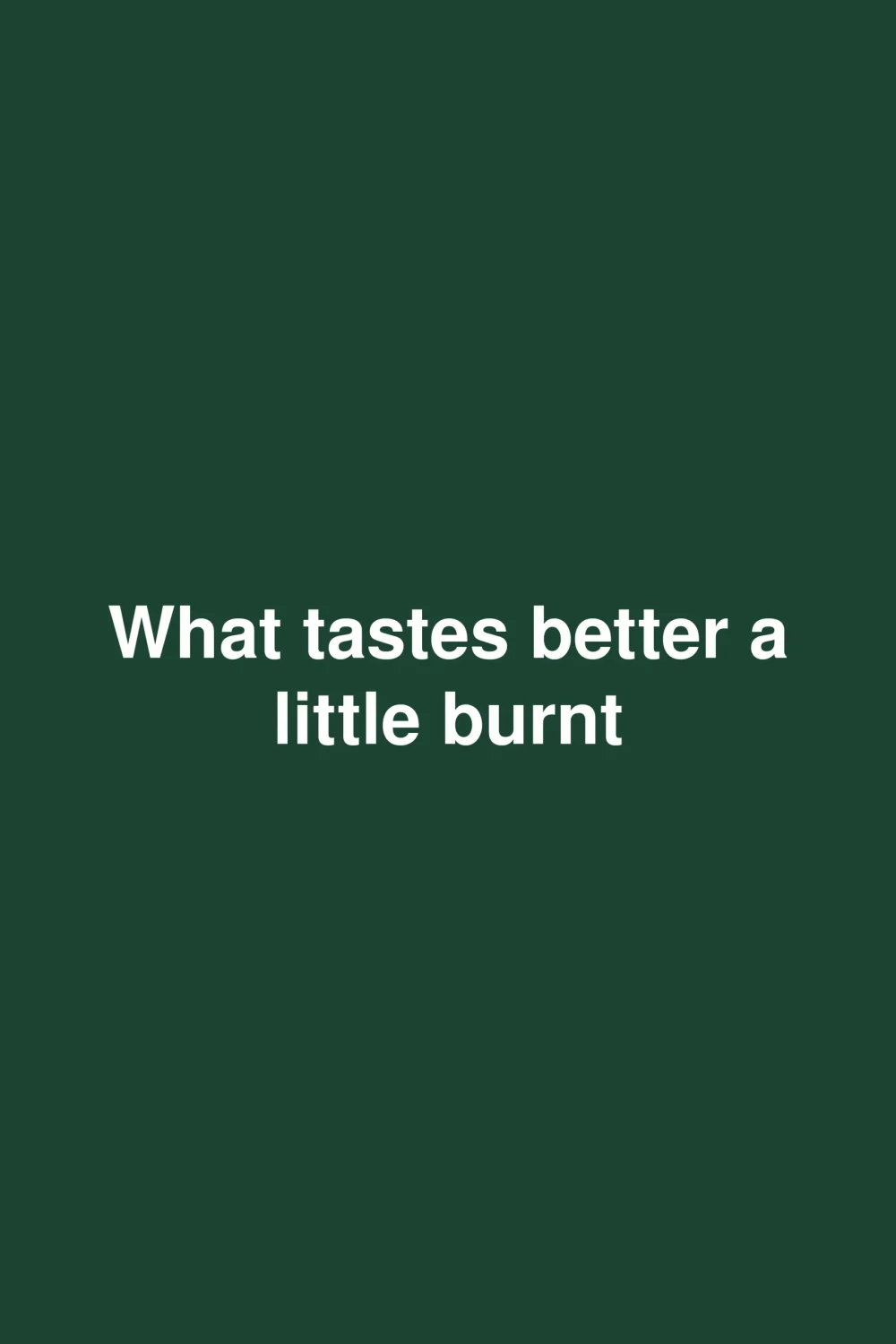Want to save this recipe?
Enter your email below and we’ll send the recipe straight to your inbox!
The Culinary Magic of Slightly Burnt Food: Why Charred Flavors Elevate Our Favorite Dishes
Have you ever bitten into a perfectly toasted marshmallow with a crispy, charred exterior, or savored the dark, caramelized edges of a cheese pizza? That slight burn—often dismissed as a cooking mistake—might actually be the secret ingredient that makes certain foods taste extraordinary. There’s science behind why many of us secretly prefer our foods with a hint of char, and understanding it can transform your everyday cooking.
The Science of Delicious Char: Understanding the Flavor Magic
That delicious burnt flavor isn’t just about being edgy or unconventional—it’s chemistry at work. When food gets that slight char, two remarkable processes occur: the Maillard reaction and caramelization.
The Maillard reaction happens when amino acids and reducing sugars transform under heat, creating hundreds of new flavor compounds. Meanwhile, caramelization occurs when sugars break down under high temperatures, developing complex sweetness with subtle bitter notes. Together, these reactions create that distinctive depth that makes slightly burnt foods so irresistible.
Rather than ruining food, controlled burning creates contrasting textures and concentrated flavors that stimulate multiple taste receptors simultaneously—something our palates find particularly exciting.
Foods That Taste Better with a Touch of Char
Marshmallows: The Campfire Classic
Nothing epitomizes summer nostalgia quite like a marshmallow that’s been deliberately set aflame and allowed to develop that perfect charred exterior. The contrast between the crispy, bitter outer layer and the molten, sweet interior creates a perfect harmony of flavors and textures that plain roasted marshmallows simply can’t match. That distinctive smoky-sweet combination is why many of us secretly hope our marshmallows catch fire when roasting them.
Caramelized Onions: Sweet Complexity
Onions undergo a magnificent transformation when cooked until they develop dark edges. The natural sugars intensify and concentrate, while the slight char adds a smoky complexity that elevates everything from burgers to French onion soup. Try cooking them longer than you normally would—until some edges turn deeply brown—for that perfect balance of sweetness and umami depth.
Grilled Meats: Flavor Sealed In
There’s a reason steakhouse chefs aim for those perfect grill marks. The charred exterior of a well-grilled steak doesn’t just look impressive—it creates a flavor-packed crust that seals in juices while adding smoky notes. The Maillard reaction works overtime here, creating hundreds of new flavor compounds that make each bite more complex and satisfying than meat that’s been merely warmed through.
Pizza Cheese: The Crispy Crown Jewel
Those spots of slightly burnt cheese on a pizza—especially where it’s bubbled over onto the crust—are often the first pieces to disappear. The concentrated dairy flavors and crispy texture contrast beautifully with the softer cheese and chewy crust. Next time you make homemade pizza, consider letting it cook just a minute longer for those prized charred cheese bits.
Toast: Beyond Golden Brown
The perfect piece of toast isn’t merely golden—it tiptoes right to the edge of being burnt. This deeper toasting develops robust flavors that stand up beautifully to toppings like avocado or jam, creating a more balanced bite. The slight bitterness of well-toasted bread also pairs wonderfully with the richness of butter, creating a more complex flavor profile than lightly toasted bread.
Roasted Vegetables: Caramelized Sweetness
Brussels sprouts, cauliflower, and carrots transform when their edges blacken slightly in a hot oven. The natural sugars caramelize while the slight char adds smoky depth, making vegetables that might otherwise seem ordinary become the highlight of the meal. Try roasting vegetables at a higher temperature (around 425°F) and letting the edges blacken for maximum flavor impact.
Crème Brûlée: The Perfect Burnt Sugar Crust
Perhaps the most celebrated example of beneficial burning is crème brûlée’s signature caramelized sugar top. That crackling layer of deliberately burnt sugar provides textural contrast and balances the custard’s sweetness with subtle bitterness. The magic happens precisely because the sugar is taken right to the edge of burning—any less would lack complexity, any more would taste acrid.
Fish with a Sear: Textural Contrast
A perfectly cooked fish fillet often features skin that’s been seared until nearly black, creating a crispy texture that contrasts beautifully with the tender flesh inside. This technique, prized in high-end restaurants, concentrates flavors while providing satisfying textural variation. The key is high heat and patience—let that skin develop deep color before flipping.
Coffee: Robust Character
Coffee enthusiasts often debate the perfect roast, but many premium coffees intentionally embrace darker profiles that approach burning. These deeper roasts develop bolder, more intense flavors with chocolate and smoky notes that cut through milk or stand strong on their own. The slight bitterness creates complexity that lighter roasts sometimes lack.
Common Burnt Food Mistakes to Avoid
While a touch of char enhances flavor, there’s still a fine line between deliciously burnt and inedibly scorched:
- Burning without purpose: Aim for intentional charring on specific parts of the food rather than overall burning.
- Using too much heat too quickly: For controlled char, moderate-high heat usually works better than maximum heat.
- Walking away during critical moments: The difference between perfect char and ruined food often comes down to mere seconds.
- Confusing “burnt” with “blackened”: Blackening is a specific technique using spices that darken during cooking—different from actual burning.
Health Benefits of Controlled Charring
While excessive charring can create potentially harmful compounds, the moderate charring we’re discussing comes with some surprising benefits:
- Digestibility: Slightly caramelized vegetables are often easier to digest than raw ones.
- Antioxidants: The Maillard reaction creates certain antioxidant compounds not present in uncooked foods.
- Flavor satisfaction: Foods with complex flavor profiles often lead to greater satisfaction with smaller portions.
Expert Recommendations for Perfect Char
Professional chefs recommend these techniques for achieving ideal charring:
- Use high-quality ingredients that can stand up to intense heat
- Ensure cooking surfaces like grills and pans are properly preheated
- For vegetables, cut them to maximize surface area for more caramelization
- When grilling, create hot zones for charring and cooler zones for gentle cooking
- Trust your nose—when the aroma shifts from appealing to acrid, you’ve gone too far
The Art of the Perfect Burn: Quick Takeaways
The magic of slightly burnt food lies in balance—finding that sweet spot where caramelization and the Maillard reaction create complexity without crossing into acrid territory. By understanding which foods benefit from char and how to achieve it, you can elevate everyday cooking into something extraordinary.
Next time you’re cooking, resist the urge to pull food from the heat when it’s merely “done.” Instead, give it that extra minute to develop those complex, slightly burnt flavors that make the difference between good food and unforgettable food.
Frequently Asked Questions
Is eating slightly burnt food harmful?
Moderate charring on food is generally considered safe. However, heavily charred or blackened foods consumed regularly may contain higher levels of potentially harmful compounds. Enjoy slightly burnt foods in moderation as part of a balanced diet.
Which cooking methods are best for achieving good char?
Grilling, broiling, wood-fired ovens, and cast-iron pan searing all excel at creating flavorful char. These high-heat, direct methods allow for quick caramelization while maintaining control.
Can you salvage food that’s been burnt too much?
For slightly over-charred food, try scraping off the most burnt portions while keeping the flavorful caramelized areas. For liquids like soups or sauces that taste burnt, adding a potato chunk (then removing it) can help absorb some burnt flavors.
Are there foods that should never be charred?
Delicate herbs, most leafy greens, and high-sugar sauces tend to burn rather than caramelize effectively. Foods with very high fat content can also develop unpleasant flavors when charred.


